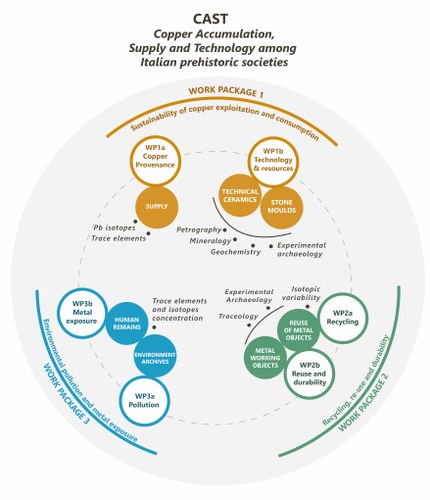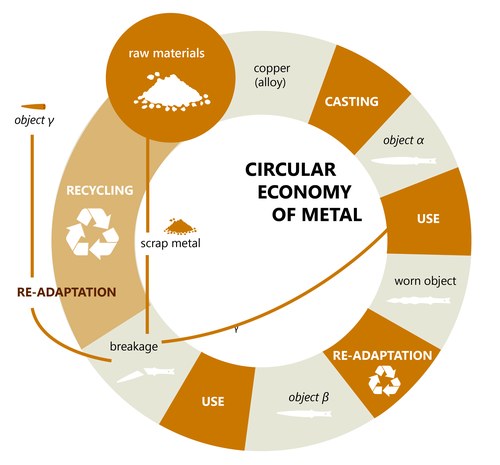CAST
Copper Accumulation Supply and Technology among Italian prehistoric societies

THE PROJECT
The CAST project – Copper Accumulation, Supply and Technology among Italian prehistoric societies, launched in January 2024 and funded by the PRIN programme of the Italian Ministry of University and Research, involves two research units: one based at the University of Bologna (PI Prof. Maurizio Cattani), and the other at the University of Modena and Reggio Emilia (PI Prof. Anna Cipriani).
This is a multidisciplinary project involving archaeologists, geologists and geochemists, exploring the entire metallurgical cycle—from copper extraction to artefact production, use, reuse and discard—as well as the impact metallurgy had on social organisation and community health during the Bronze Age (late 3rd–2nd millennium BCE).
The focus is on northern Italy, particularly the area associated with the Terramare culture (Po Plain). By considering several key sites, the CAST project aims to combine archaeometric analyses, 3D reconstructions and experimental archaeology to develop a comprehensive methodological protocol for the study of ancient metallurgical activities and the reconstruction of the entire chaîne opératoire of metal production.
⛰️ COPPER SOURCES: copper mineralisations in the northern Apennines
- Copper mineralisations in the northern Italian Apennines are primarily associated with ophiolitic complexes (magmatic rocks originating from the ancient Tethys Ocean basin).
- Copper is often present in the form of sulphide minerals such as chalcopyrite and bornite, which occur in veins and are disseminated within the host rocks; alteration products include malachite and azurite. Native copper is very rare but does occur, particularly in areas with significant hydrothermal activity.
- In Emilia-Romagna, several historical mines are found, mainly in the provinces of Piacenza, Modena and Bologna (especially in the areas of Vigonzano-PC, Val Dragone-MO and Bisano-BO).
- One of the project's goals is to evaluate whether any of these mineralisations were exploited during the Bronze Age. In addition to collecting new samples in the field, the project also considers landscape features, resource availability, and the visibility of potential sites.
🔬 ARCHAEOMETRIC ANALYSES: the MeGic Lab at UniMORE
Analyses on copper mineralisations:
- Major elements through XRF and/or EMPA
- Trace elements through ICP-MS
- Lead isotopes through MC-ICPMS
These are used to define distinct geochemical domains among known/exploited mines.
Analyses on copper/bronze archaeological artefacts:
- Major elements through EMPA
- Trace elements through ICP-MS
- Lead isotopes through MC-ICPMS
These aim to identify the provenance of the metal used.
⛏️ CASE STUDIES: archaeological excavations
The University of Bologna is currently conducting excavations at Monte della Croce (BO), Mursia (TP) and Solarolo (RA), and is analysing data from a recent excavation at Caorso (PC), carried out by the archaeological cooperative "Archeosistemi".
Traces associated with secondary metallurgical activities have been found at Solarolo and Mursia and are currently under investigation.
👩💻 RELATIONAL DATABASE
The UniBO research unit is compiling a relational database that integrates various types of information on artefacts (provenance, analyses, morphological descriptions, drawings, typology, etc.), linked to a GIS system that includes all known Bronze Age sites in Italy.
This enables the creation of distribution maps. Initially focused on ceramic finds—over 20,000 records inserted—the database is currently being expanded to include metal artefacts.
🔥 EXPERIMENTAL ARCHAEOLOGY
Experimental archaeology complements archaeometric analyses (such as those on technical ceramics) and use-wear analysis.
💻 DIGITAL ARCHAEOLOGY
The acquisition of a substantial number of 3D models serves the triple purpose of documentation, dissemination, and potential research applications, such as use-wear analysis.
3D models of casting moulds housed in major museums in Emilia, as well as those recovered from the excavation at Mursia—which preserve rich evidence of manufacturing—have enabled extremely high-quality, detailed documentation, which would be difficult to achieve through photographs and drawings alone.
♻️ SUSTAINABILITY
The economy of metallurgical production in the Bronze Age holds particular significance, as modern concepts of circular economy, recycling, and sustainability find some of their earliest expressions in this period.
Copper and its alloys were in fact the first fully recyclable materials used in prehistory, allowing for continuous reuse and reworking. The scarcity of natural sources of copper and tin (which together form bronze), as well as the long-distance nature of procurement networks, further encouraged the systematic recycling of metal.
This technology also had a significant environmental impact: several studies of prehistoric contexts across Europe have revealed a notable increase in heavy metal pollution in the environment, alongside growing exposure in human populations.

👨🔬 TEAM
PRINCIPAL INVESTIGATORS
- Maurizio Cattani: Associate Professor in Prehistory and Protohistory at the Department of History and Cultures, University of Bologna.
- Anna Cipriani: Associate Professor in Geochemistry and Volcanology at the Department of Chemical and Geological Sciences, University of Modena and Reggio Emilia.
UNIVERSITY OF BOLOGNA
- Claudio Cavazzuti: Researcher in Prehistory and Protohistory, he investigates mobility during the Bronze Age through an integrated approach combining bioarchaeology and isotopic analysis. His work also includes pre- and protohistoric metallurgy and experimental archaeology. He is the director of the excavation at Monte della Croce (Gaggio Montano-BO) as part of an Upland Archaeology project focused on the Tuscan-Emilian Apennines.
- Florencia Inés Debandi: Postdoctoral Research Fellow in Prehistory and Protohistory, expert in ancient diet and resource management. She actively participates in several Bronze Age projects in Italy (Solarolo, Pantelleria, Sardinia). For years, she has employed experimental archaeology techniques to reconstruct specific production processes.
- Francesca Barchiesi: Postdoctoral Research Fellow in Prehistory and Protohistory, her research focuses on pre- and protohistoric contexts in Italy and the southeastern Arabian Peninsula. Aiming to deepen understanding of technology, production processes, and the use of various classes of artefacts (for CAST, primarily metal and macrolithic tools), she employs use-wear analysis and digital technologies applied to archaeology (photogrammetry).
UNIVERSITY OF MODENA AND REGGIO EMILIA
- Maria De Falco: archaeometric analysis
- Federico Lugli: isotopic geochemistry
- Daniele Brunelli: petrology
- Elena Armaroli: isotopic analysis
- Sara T. Levi: study of ancient ceramics through an integrated archaeological, technological, and archaeometric approach
Highlights
-
MeGic Lab
Metallomics and Geochemistry research
-
MeGic Lab
Facebook page
-
Prehistory@UNIBO
Facebook page
Contacts
Maurizio Cattani
P.I. of the research unit at the University of Bologna
Anna Cipriani
P.I. of the research unit at the University of Modena and Reggio Emilia